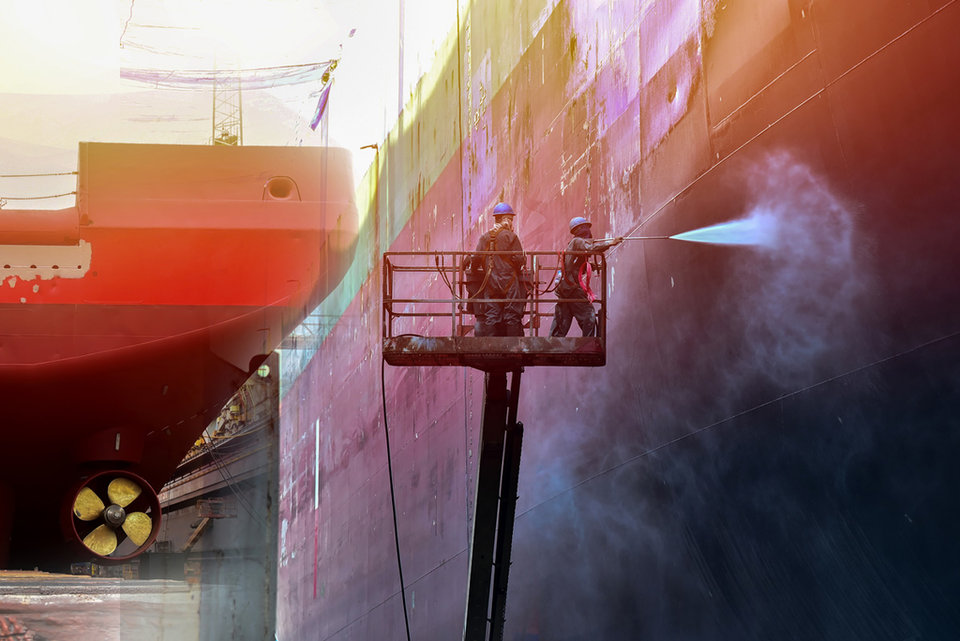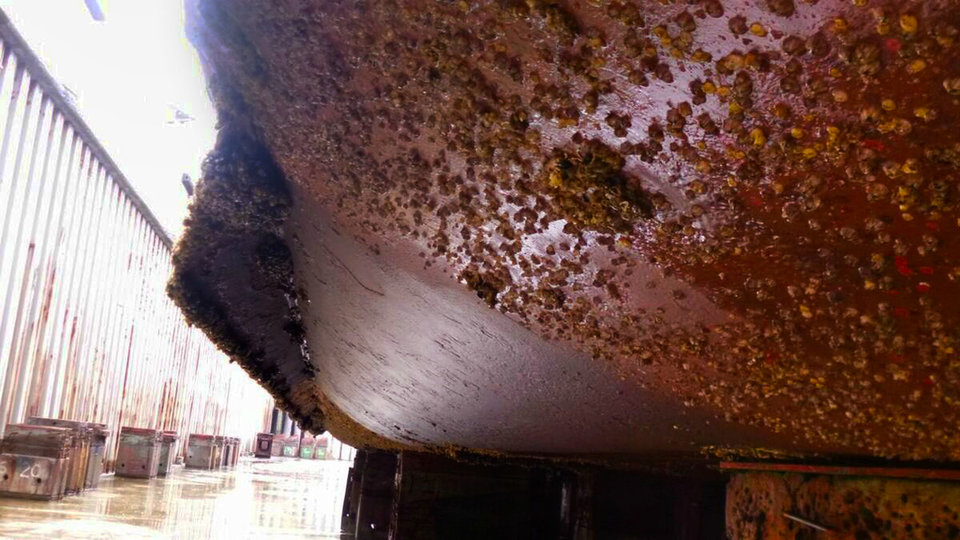Portsmouth, home to the UK’s second-largest international port. Image: skyearth / Shutterstock
ENVIRONMENT
Biofouling:
derailing decarbonisation and ship optimisation
The build-up of barnacles and other organisms, such as plants, algae and bacteria, on ship hulls has been a consistent problem for the maritime industry. Dr Markus Hoffmann, technical director at biotechnology company I-Tech AB, explains why tackling biofouling will be crucial for shipping’s push towards decarbonisation.
Published in early October 2020, the results of the latest Global Maritime Forum Issues Monitor cite economic concerns and looming decarbonisation deadlines as two major ingredients in a cocktail of stresses facing maritime decision-makers.
Adding to that, the recently published Fourth IMO Greenhouse Gas Study demonstrates that the entire shipping industry’s efforts to decarbonise must accelerate steeply in coming years.
Based on the results of the Global Maritime Forum survey, preparation will be the watchword for shipping over the coming decades. Therefore, shipowners need to be examining every possible opportunity to optimise the performance of their vessels to achieve the dual purpose of minimising operating expenditure alongside reducing excess carbon emissions.
Responding to these pressing environmental and economic challenges, the shipping fleet of the future will be quite different from that of today. One thing that will remain constant, however, is that we must not take our eye off the ball when preparing to protect ships against the impact of biofouling. Ignoring the potential impact of biofouling on the hull could derail the bold decarbonisation plans the industry is making during these uncertain times.

I-Tech AB technical director Dr Markus Hoffmann.
Image: I-Tech AB
Hard fouling: shipping’s efficiency and commercial drain
Hard fouling from shell-forming creatures such as barnacles results in higher engine demands or speed losses. Their volcano-shaped, hard outer shell creates turbulence across the hull surface when a ship travels through water.
Estimates of the cumulative impact of excessive hydrodynamic drag created by hard fouling creatures are a stark wake-up call, and we must be vigilant in preventing their harmful effects from being felt.
44% of vessels had what marine coating experts would deem to be ‘unacceptable’ underwater hull fouling coverage levels
This year, I-Tech AB, developers of the antifouling technology ingredient for marine coatings Selektope, commissioned marine coatings consultants Safinah Group to analyse hull condition data that accurately sampled a selection of vessels to determine the prevalence of hard fouling across the global shipping fleet.
Based on hull inspection reports from dry-dockings of 249 deep-sea trading vessels between 2015-2019, hard fouling was found to be on nearly every ship surveyed. Even more shocking was the finding that 44% of these vessels had what marine coating experts would deem to be ‘unacceptable’ underwater hull fouling coverage levels, with more than 10% of the surface area covered by hard fouling.
Assuming this sample accurately represents the prevalence of hard fouling across the global commercial fleet, based on data from another 2011 study by Michael Schultz, more than 110 million tonnes is piled on shipping’s carbon footprint by hard fouling on ship hulls alone.

A ship hull being cleaned with a high-pressure water jet system. Image: Tawansak / Shutterstock
The financial impact of barnacle fouling
Furthermore, hard fouling by barnacles could be adding at least $6bn onto the global bunker bill every year. Alarmingly, this figure could be significantly higher, since this estimate was based on just 10% fouling coverage across 44% of the world’s commercial fleet, but we know a proportion of vessels had significantly higher coverage levels than 10%.
The extra $6bn on shipping’s bunker bill could inflate significantly with market volatility and the anticipated higher cost of low and zero-carbon fuels that make up the alternative fuel landscape set to power the fleets of the future.
2020 has pushed large portions of the shipping industry into idle operations in an unprecedented way. From diminished container demand due to reduced manufacturing output, higher demand for offshore storage in tankers and unoccupied cruise and passenger vessels, more ships have been sitting still.
Fouling is starting to fall under the regulatory spotlight, much like ballast water treatment
As barnacle fouling only occurs on hulls that are static in the water for a few weeks or more, the current extent of unacceptable hard fouling coverage could have already spiked significantly beyond 44% of the global fleet.
However, the shipping industry is also starting to appreciate that the costs of biofouling go beyond just higher emissions and bunker bills. With shipping looking to improve its environmental credentials further by minimising its role in the spread of invasive aquatic species, fouling is starting to fall under the regulatory spotlight, much like ballast water treatment.
Port authorities in New Zealand already deny entry to vessels with fouled hulls and Californian ports require a hull condition report to be filed before entry to minimise the biosecurity risk. The IMO GloFouling partnership and IMO resolution MEPC.207(62) indicates that the current regional focus to preserve delicate marine ecosystems could become a global effort. Thus, generating another commercial risk on the horizon from fouling as hull condition could fall on the wrong side of growing legislations.

Static ships are a magnet for marine fouling. Image: I-Tech AB
Antifouling technology: providing a solution for owners
Just as owners need to be proactive to minimise operating expenditure as part of their commercial planning and carefully consider a viable decarbonisation pathway, they need to be considering how best to tackle hard fouling.
While there is no silver bullet, a preventative approach is the most sensible mindset. Getting proactive on biofouling prevention by using an effective antifouling coating removes the need to resort excessively to hull cleaning solutions. While effective on soft fouling, the abrasive action to remove hard fouling often necessitates a costly result of expensive dry-docking and new marine coating application.
The most salient start that owners can take in getting proactive on biofouling prevention is to examine the idle day period guarantees provided with hull coatings. Static ships are a magnet for marine fouling, and if 2020 has demonstrated anything, it has shown shipping that unexpected idle periods could emerge from any corner. A recent example is the growing lines of dry-bulkers importing Australian coal into China that have spent weeks on end waiting to offload while negotiating stricter government import controls.
Shipping cannot afford to let hard fouling be a commercial and environmental thorn in the industry’s side
Most antifouling technology coatings come with 14 to 21-day guarantees. However, premium antifouling coatings containing Selektope often come with 30-day idle period guarantees or more. Although premium antifouling coatings also come with a higher cost, if a risk-based analysis shows a high chance of a vessel being static, especially in the sub-tropical and tropical waters, premium coatings that effectively prevent hard fouling accumulation could be the determining factor between profit and loss.
With at least 110 million tonnes of excess carbon that can be attributed to barnacle fouling and billions of extra dollars in fuel costs wasted per year, shipping cannot afford to let hard fouling be a commercial and environmental thorn in the industry’s side. Given the challenging environment of decarbonisation and escalating commercial pressures, a preventative approach following appraisal of idle-period risk versus idle day guarantees offered for each antifouling coating system presents the best first step.
With foul-free hulls, shipping will sail into a future operating profile that encapsulates environmental sustainability in a commercially viable way.
Headline image: caption. Image: